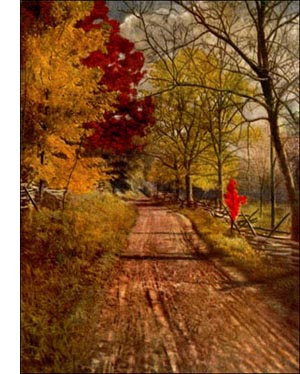Honey Locust or Three Thorned Acacia Tree
 Honey Locust, Three-thorned Acacia (Gleditsia triacanthos, Linn.)-A large, handsome tree, 70 to 140 feet high, with rigid, horizontal branches; trunk 3 to 5 feet in diameter. Bark rough, dark, deeply furrowed; twigs brown, smooth. Thorns in second year, 3-pronged, single, or in close-set clusters. Wood reddish brown, heavy, durable, hard.
Honey Locust, Three-thorned Acacia (Gleditsia triacanthos, Linn.)-A large, handsome tree, 70 to 140 feet high, with rigid, horizontal branches; trunk 3 to 5 feet in diameter. Bark rough, dark, deeply furrowed; twigs brown, smooth. Thorns in second year, 3-pronged, single, or in close-set clusters. Wood reddish brown, heavy, durable, hard. Buds clustered, nearly hidden in winter; spine bud some distance above axillary buds. Leaves 7 to 8 inches long, alternate, once or twice pinnately compound, soft, velvety, and pink when opening, changing to dark green with paler linings; yellow in autumn. Flowers inconspicuous, regular, in small greenish racemes, staminate and pistillate racemes separate on the same or on different trees.
Fruits purple, curving, flat pods, 6 to 18 inches long; seeds 10 to 15, hard, flat, brown. Preferred habitat, rich woods. Distribution, New York and Pennsylvania to Mississippi and Texas; Ontario to Michigan and Arkansas. Uses: Ornamental and shade tree much cultivated. Good hedge tree. Wood used for wheel hubs. fencing, and for fuel.
Unlike its relative, the yellow locust, this tree is strikingly handsome and full of character in winter. Its bark, from root to twig, is brown and "alive-looking," though no buds are in sight, and the bark furrows are deep on a large tree. "There is all the difference in the world between a dead grey and a lively brown. The locusts well illustrate this difference.
The honey locust has angular branches, slender and wiry, which extend far out in horizontal planes. These branches shine as if they were polished. The three-pronged thorns give an added asperity to the demeanour of the tree. The rattling pods are purple and shiny. They curve and cluster on the topmost limbs, and long defy the' efforts of the wind to dislodge them.
The thorns of the honey locust are thorns indeed-modified branches that branch again, and are rooted in the very pith of the twig that bears them. The "thorns" of the yellow locust are prickles-merely skin deep. Occasionally a leaf appears on the side of a young thorn to strengthen the evidence that the thorn is a branch changed to a special form to serve a special use. But the thorns stop growing when they reach about a foot in length, and remain indefinitely in their places, ranging along the branches or clustered on the trunk, even encircling it in some instances with the most formidable chevaux-de-frise -a barrier to the ambitions of climbing boys, and to cropping cows which like the taste of locust foliage. There is a thornless variety which is the delight of boys who climb for the sweet pods in summer time.
The foliage mass of the honey locust is wonderfully light and graceful. New leaves with a silvery sheen upon them are constantly appearing; some once, some twice compound, on the same tree. The colour of them is a clear, intense emerald. The pods in midsummer show many shades of changeable red and green velvet against the leaves, and are as beautiful in form as in colour and texture.
In this stage of growth the pods contain a sweet, edible pulp which later dries and turns bitter. An Old-World tree has pods that are thicker but otherwise resemble those of the honey locust; these sweetish pods are sold on the streets of New York as "St. John's Bread," and are believed to be the locusts eaten by John the Baptist in the wilderness.
The curving, S-shaped pods of the honey locust hang on the tree until winter, when the wind whirls them along over the icy ground until they lodge. Here the seeds eventually soften and germinate, and saplings spring up far from the parent tree. The range of this tree is extensive, but it has nowhere a very plentiful growth. The wood is not as well known nor as fully appreciated as it deserves. The claims of the tree for ornamental planting and for shade are granted by enterprising nurserymen. It is a handsome park tree, and thrives in almost any soil. It is hardy, and endures heavy pruning. This character combined with its thorns make it one of the best of our native hedge plants. It is necessary to soften the hard seeds in hot water before planting, else they will not germinate until the second year.
Unlike most of the pod-bearers, the honey locust has greenish, inconspicuous flowers, not of the pea-blossom form. The bees find them, as they are fragrant and nectar laden. The "honey" mentioned in the name is not in the flower but in the half-ripe fruit.